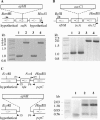Regulatory roles for IscA and SufA in iron homeostasis and redox stress responses in the cyanobacterium Synechococcus sp. strain PCC 7002
- PMID: 16621810
- PMCID: PMC1447454
- DOI: 10.1128/JB.188.9.3182-3191.2006
Regulatory roles for IscA and SufA in iron homeostasis and redox stress responses in the cyanobacterium Synechococcus sp. strain PCC 7002
Abstract
SufA, IscA, and Nfu have been proposed to function as scaffolds in the assembly of Fe/S clusters in bacteria. To investigate the roles of these proteins further, single and double null-mutant strains of Synechococcus sp. strain PCC 7002 were constructed by insertional inactivation of genes homologous to sufA, iscA, and nfu. Demonstrating the nonessential nature of their products, the sufA, iscA, and sufA iscA mutants grew photoautotrophically with doubling times that were similar to the wild type under standard growth conditions. In contrast, attempts to inactivate the nfu gene only resulted in stable merodiploids. These results imply that Nfu, but not SufA or IscA, is the essential Fe/S scaffold protein in cyanobacteria. When cells were grown under iron-limiting conditions, the iscA and sufA mutant strains exhibited less chlorosis than the wild type. Under iron-sufficient growth conditions, isiA transcript levels, a marker for iron limitation in cyanobacteria, as well as transcript levels of genes in both the suf and isc regulons were significantly higher in the iscA mutant than in the wild type. Under photosynthesis-induced redox stress conditions, the transcript levels of the suf genes are notably higher in the sufA and the sufA iscA mutants than in the wild type. The growth phenotypes and mRNA abundance patterns of the mutant strains contradict the proposed scaffold function for the SufA and IscA proteins in generalized Fe/S cluster assembly and instead suggest that they play regulatory roles in iron homeostasis and the sensing of redox stress in cyanobacteria.
Figures






Similar articles
-
IscA/SufA paralogues are required for the [4Fe-4S] cluster assembly in enzymes of multiple physiological pathways in Escherichia coli under aerobic growth conditions.Biochem J. 2009 May 27;420(3):463-72. doi: 10.1042/BJ20090206. Biochem J. 2009. PMID: 19309314 Free PMC article.
-
Complementary roles of SufA and IscA in the biogenesis of iron-sulfur clusters in Escherichia coli.Biochem J. 2008 Jan 15;409(2):535-43. doi: 10.1042/BJ20071166. Biochem J. 2008. PMID: 17941825
-
Deletion of the Proposed Iron Chaperones IscA/SufA Results in Accumulation of a Red Intermediate Cysteine Desulfurase IscS in Escherichia coli.J Biol Chem. 2015 May 29;290(22):14226-34. doi: 10.1074/jbc.M115.654269. Epub 2015 Apr 23. J Biol Chem. 2015. PMID: 25907559 Free PMC article.
-
Diversity and Evolution of Iron Uptake Pathways in Marine Cyanobacteria from the Perspective of the Coastal Strain Synechococcus sp. Strain PCC 7002.Appl Environ Microbiol. 2023 Jan 31;89(1):e0173222. doi: 10.1128/aem.01732-22. Epub 2022 Dec 20. Appl Environ Microbiol. 2023. PMID: 36533965 Free PMC article.
-
Iron-Sulfur Cluster Biogenesis and Iron Homeostasis in Cyanobacteria.Front Microbiol. 2020 Feb 28;11:165. doi: 10.3389/fmicb.2020.00165. eCollection 2020. Front Microbiol. 2020. PMID: 32184761 Free PMC article. Review.
Cited by
-
Iron-sulfur (Fe/S) protein biogenesis: phylogenomic and genetic studies of A-type carriers.PLoS Genet. 2009 May;5(5):e1000497. doi: 10.1371/journal.pgen.1000497. Epub 2009 May 29. PLoS Genet. 2009. PMID: 19478995 Free PMC article.
-
DsrR, a novel IscA-like protein lacking iron- and Fe-S-binding functions, involved in the regulation of sulfur oxidation in Allochromatium vinosum.J Bacteriol. 2010 Mar;192(6):1652-61. doi: 10.1128/JB.01269-09. Epub 2010 Jan 8. J Bacteriol. 2010. PMID: 20061482 Free PMC article.
-
Transcript profiling reveals new insights into the acclimation of the mesophilic fresh-water cyanobacterium Synechococcus elongatus PCC 7942 to iron starvation.Plant Physiol. 2008 Jun;147(2):747-63. doi: 10.1104/pp.107.114058. Epub 2008 Apr 18. Plant Physiol. 2008. PMID: 18424627 Free PMC article.
-
Iron-sulfur cluster biogenesis and human disease.Trends Genet. 2008 Aug;24(8):398-407. doi: 10.1016/j.tig.2008.05.008. Epub 2008 Jul 5. Trends Genet. 2008. PMID: 18606475 Free PMC article. Review.
-
Building Fe-S proteins: bacterial strategies.Nat Rev Microbiol. 2010 Jun;8(6):436-46. doi: 10.1038/nrmicro2356. Nat Rev Microbiol. 2010. PMID: 20467446 Review.
References
-
- Agar, J. N., C. Krebs, J. Frazzon, B. H. Huynh, D. R. Dean, and M. K. Johnson. 2000. IscU as a scaffold for iron-sulfur cluster biosynthesis: sequential assembly of [2Fe-2S] and [4Fe-4S] clusters in IscU. Biochemistry 39:7856-7862. - PubMed
-
- Behshad, E., S. E. Parkin, and J. M. Bollinger, Jr. 2004. Mechanism of cysteine desulfurase Slr0387 from Synechocystis sp. PCC 6803: kinetic analysis of cleavage of the persulfide intermediate by chemical reductants. Biochemistry 43:12220-12226. - PubMed
-
- Beinert, H., and P. J. Kiley. 1999. Fe-S proteins in sensing and regulatory functions. Curr. Opin. Chem. Biol. 3:152-157. - PubMed
-
- Bibby, T. S., J. Nield, and J. Barber. 2001. Iron deficiency induces the formation of an antenna ring around trimeric photosystem I in cyanobacteria. Nature 412:743-745. - PubMed
Publication types
MeSH terms
Substances
LinkOut - more resources
Full Text Sources
Other Literature Sources
Medical
Molecular Biology Databases
Miscellaneous

